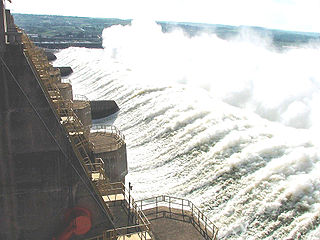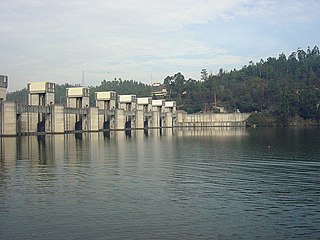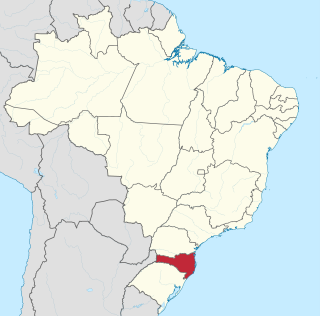
The Itaipu Dam is a hydroelectric dam on the Paraná River located on the border between Brazil and Paraguay. The construction of the dam was first contested by Argentina, but the negotiations and resolution of the dispute ended up setting the basis for Argentine–Brazilian integration later on.
RoboTurb is a welding robot used to repair turbine blades developed at Universidade Federal de Santa Catarina. It is a redundant robot with a flexible rail.

Eletrobras is a major Brazilian electric utilities company. The company's headquarters are located in Rio de Janeiro.

The Belo Monte Dam is a hydroelectric dam complex currently under construction on the northern part of the Xingu River in the state of Pará, Brazil. The planned installed capacity of the dam complex would be 11,233 megawatts (MW), which would make it the second largest hydroelectric dam complex in Brazil and fourth largest in the world by installed capacity, behind the Three Gorges Dam and the Xiluodu Dam in China and the Brazilian-Paraguayan Itaipu Dam. Considering the oscillations of flow river, guaranteed minimum capacity generation from the Belo Monte Dam would measure 4,571 MW, 39% of its maximum capacity.

The Tucuruí Dam is a concrete gravity dam on the Tocantins River located on the Tucuruí County in the State of Pará, Brazil. The main purpose of the dam is hydroelectric power production and navigation. It is the first large-scale hydroelectric project in the Brazilian Amazon rainforest. The installed capacity of the 25-unit plant is 8,370 megawatts (11,220,000 hp). Phase I construction began in 1980 and ended in 1984 while Phase II began in 1998 and ended in 2010. The dam was featured in the 1985 film The Emerald Forest.
Companhia de Transmissão de Energia Elétrica Paulista is one of transmission system operators of electric power grid in Brazil. The company is headquartered in São Paulo.

Campos Novos is a city in Santa Catarina, in the Southern Region of Brazil. Campos Novos is a pioneer in production of pollen and the biggest grain and oat producer of Santa Catarina. The municipality invests also into fatstock and poultry farming.

The Xingó Dam is a concrete face rock-fill dam on the São Francisco River on the border of Alagoas and Sergipe, near Piranhas, Brazil. The dam was built for navigation, water supply and hydroelectric power generation as it supports a 3,162 megawatts (4,240,000 hp) power station. It was constructed between 1987 and 1994 and the last of its generators was commissioned in 1997. In Portuguese, the dam is called the Usina Hidrelétrica de Xingó.

The Itá Hydroelectric Power Plant is a dam and hydroelectric power plant on the Uruguay River near Itá on the border of Santa Catarina and Rio Grande do Sul, Brazil. The power station has a 1,450 megawatts (1,940,000 hp) capacity and is supplied with water by a concrete face rock-fill embankment dam. It is owned and operated by Tractebel Energia and produces the equivalent of 60% of the energy consumed in Santa Catarina.

The Machadinho Hydroelectric Power Plant is a dam and hydroelectric power plant on the Pelotas River near Machadinho on the border of Santa Catarina and Rio Grande do Sul, Brazil. The power station has a 1,140 MW (1,530,000 hp) capacity and is supplied with water by a concrete face rock-fill embankment dam. It is owned and operated by Machadinho Energetica and produces the equivalent of 37% of the energy consumed in Santa Catarina.

The Barra Grande Hydroelectric Power Plant is a dam and hydroelectric power plant on the Pelotas River near Celso Ramos on the border of Santa Catarina and Rio Grande do Sul, Brazil. The power station has a 708 MW capacity and is supplied with water by a concrete face rock-fill embankment dam, the second tallest dam in Brazil. It is owned and operated by Energética Barra Grande SA (BAESA) and produces a 30% equivalent of the demand in Santa Catarina.
José Antunes Sobrinho is a Brazilian civil engineer and energy executive who specializes in hydroelectric and other energy projects. He holds a degree from the Federal University of Paraná (1974) and a Master's degree in hydraulic engineering from the Delft University of Technology, Netherlands (1978).

Aguieira Dam also known as Foz do Dão Dam is a concrete multiple arch dam on the Mondego River, where the river forms the border line between the districts of Coimbra and Viseu. It is located in the municipality Penacova, in Coimbra District, Portugal.

Cabril Dam is a concrete double curvature arch dam on the Zêzere River, where the river forms the border line between the districts of Castelo Branco and Leiria. It is located in the municipality Sertã, in Castelo Branco District, Portugal.

Salamonde Dam is a concrete arch dam on the Cávado River, where the river forms the border line between the districts of Braga and Vila Real. It is located in the municipality Vieira do Minho, in Braga District, Portugal.

Crestuma-Lever Dam is a concrete gravity dam on the Douro. It is located in the municipality Vila Nova de Gaia, in Porto District, Portugal.

The Cachoeira do Cai Dam is a planned hydroelectric dam on the Jamanxim River in the state of Pará, Brazil, with a capacity of 802 megawatts (1,075,000 hp).

The Cachoeira dos Patos Dam is a proposed hydroelectric dam on the Jamanxim River in the state of Pará, Brazil. Work has been delayed due to concern about environmental impact and lack of consultation with affected indigenous people.

The Jamanxim Dam is a proposed hydroelectric dam on the Jamanxim River in the state of Pará, Brazil.


























